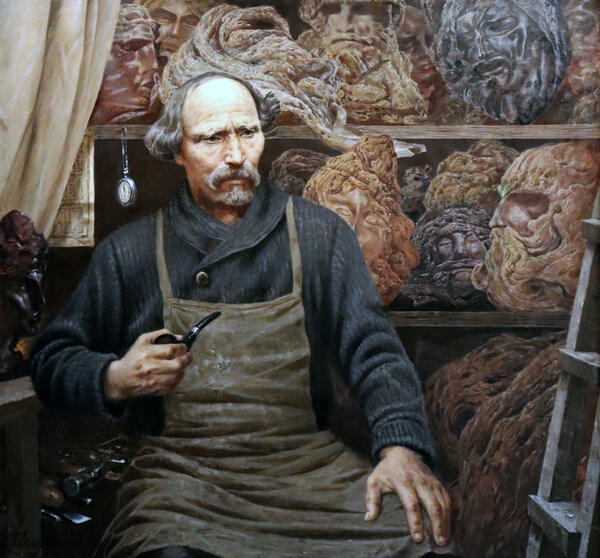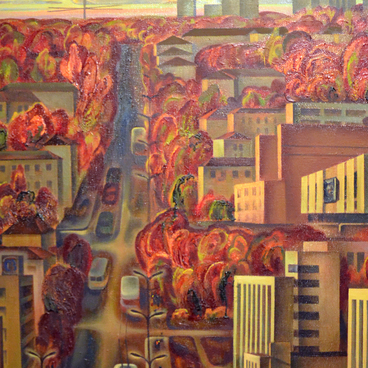Igor Sidelnikov (1937–2020), who painted the presented portrait, was an Honored Artist of Russia and People’s Artist of the Republic of Mordovia. He received a complete education: he had classes at an art studio for children, graduated from the Penza Art School, and then the Surikov Moscow State Art Institute in 1968. After a two-year internship at the Academy of Arts of the USSR, he had many opportunities to stay and work in the capital. Nevertheless, Igor Sidelnikov preferred to return to Mordovia to his hometown.
The painter actively participated in the cultural life of his small motherland, he organized exhibitions and helped novice artists. Igor Sidelnikov received the title of Honorary Citizen of Ruzayevka for his contribution to the cultural development of the Russian hinterland. In 2018, the artist held a major exhibition in honor of his 80th birthday.
Igor Sidelnikov created several works dedicated to the famous sculptor Stepan Erzia. Stepan Dmitrievich Erzia (1876–1959) started his career in icon painting and studied at the Moscow School of Painting, Sculpture and Architecture (1902–1907). Fate brought his artworks to the best galleries of that time and made his name known all over the world. Over the years, Stepan Erzia lived in Italy, France, Argentina, communicated with outstanding people of his time.
The 1996 portrait turned out to be the most poignant and internally dramatic: for more than 20 years, the Mordovian sculptor was forced to live far from his homeland.
Sidelnikov’s painting is not just a portrait of a famous sculptor, it is a representation of the entire world of an outstanding personality. This world is recreated on the canvas with the help of numerous significant details, for instance, the foreign calendar behind Erzia’s back which hints at the forced emigration of the sculptor that lasted from 1927 to 1950.
Another symbol of how much Stepan Erzia awaited his return to his homeland is the image of a round pocket watch over the sculptor’s right shoulder. Together with the calendar, they remind the viewer of the days and hours that the sculptor spent away from family and friends.
The setting is also chosen for a reason. In his personal life, Stepan Erzia was lonely, he had no family. The master called his works his “children”. He is depicted surrounded by numerous sculptures, which are rendered quite accurately. During his lifetime, Erzia was able to keep a large collection of his sculptures and subsequently donated them to the state.
The painter actively participated in the cultural life of his small motherland, he organized exhibitions and helped novice artists. Igor Sidelnikov received the title of Honorary Citizen of Ruzayevka for his contribution to the cultural development of the Russian hinterland. In 2018, the artist held a major exhibition in honor of his 80th birthday.
Igor Sidelnikov created several works dedicated to the famous sculptor Stepan Erzia. Stepan Dmitrievich Erzia (1876–1959) started his career in icon painting and studied at the Moscow School of Painting, Sculpture and Architecture (1902–1907). Fate brought his artworks to the best galleries of that time and made his name known all over the world. Over the years, Stepan Erzia lived in Italy, France, Argentina, communicated with outstanding people of his time.
The 1996 portrait turned out to be the most poignant and internally dramatic: for more than 20 years, the Mordovian sculptor was forced to live far from his homeland.
Sidelnikov’s painting is not just a portrait of a famous sculptor, it is a representation of the entire world of an outstanding personality. This world is recreated on the canvas with the help of numerous significant details, for instance, the foreign calendar behind Erzia’s back which hints at the forced emigration of the sculptor that lasted from 1927 to 1950.
Another symbol of how much Stepan Erzia awaited his return to his homeland is the image of a round pocket watch over the sculptor’s right shoulder. Together with the calendar, they remind the viewer of the days and hours that the sculptor spent away from family and friends.
The setting is also chosen for a reason. In his personal life, Stepan Erzia was lonely, he had no family. The master called his works his “children”. He is depicted surrounded by numerous sculptures, which are rendered quite accurately. During his lifetime, Erzia was able to keep a large collection of his sculptures and subsequently donated them to the state.




